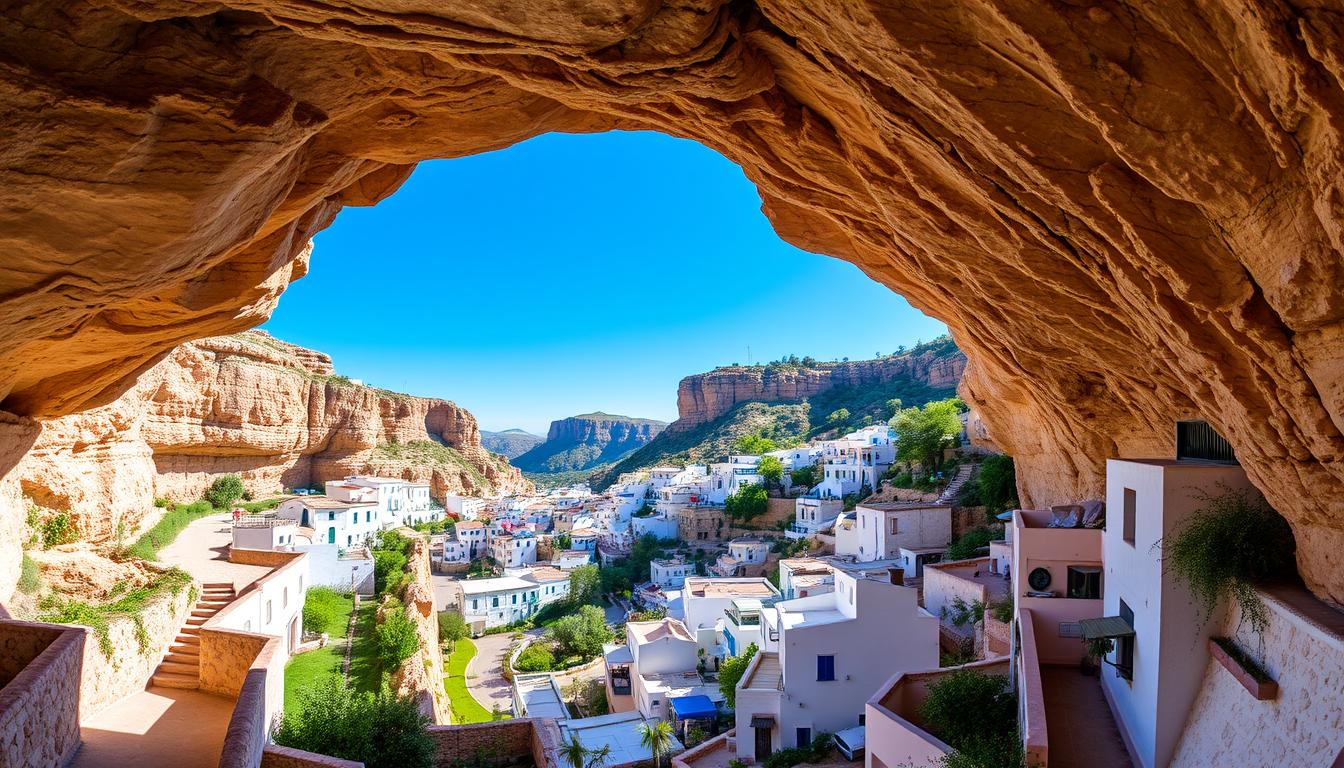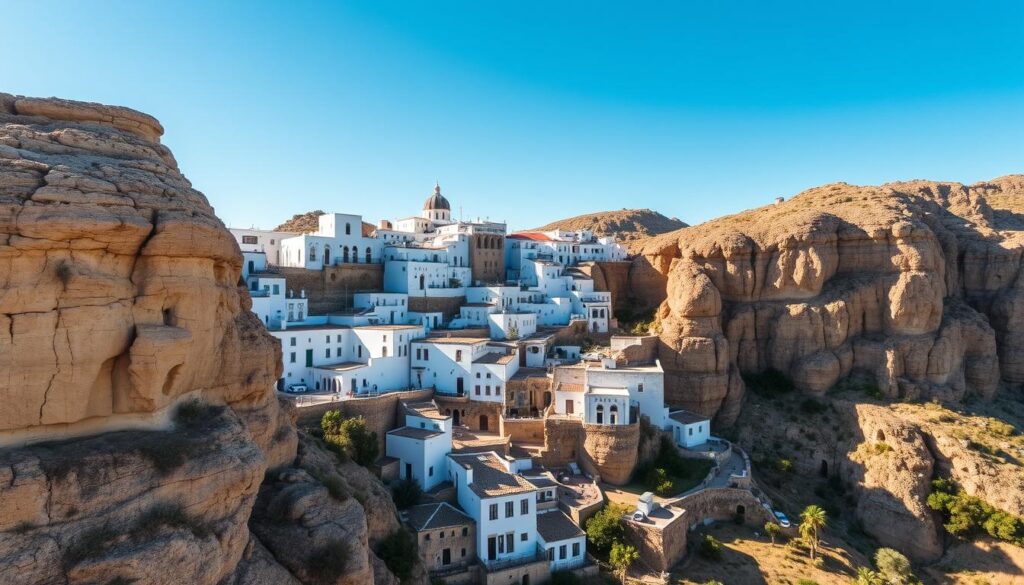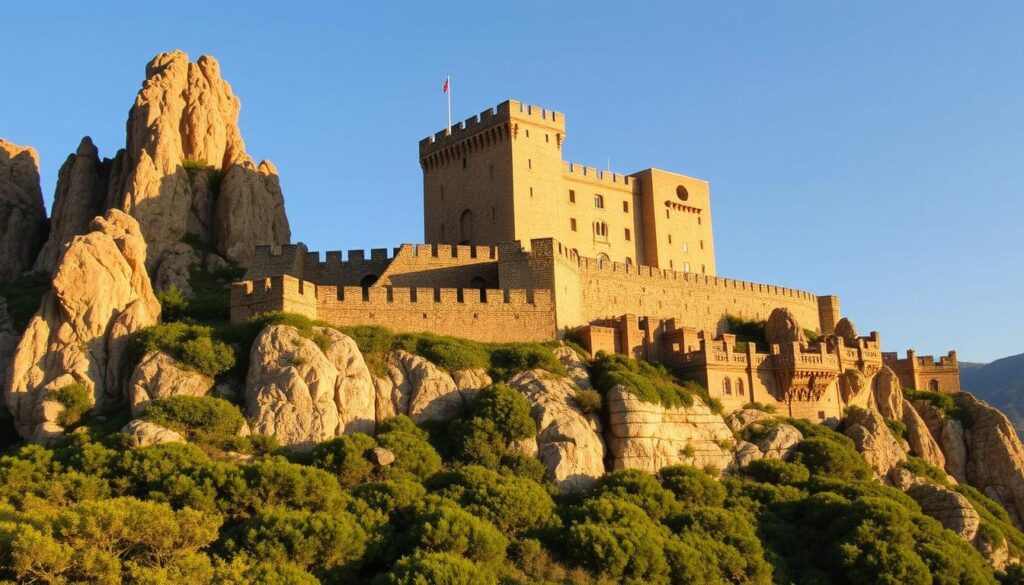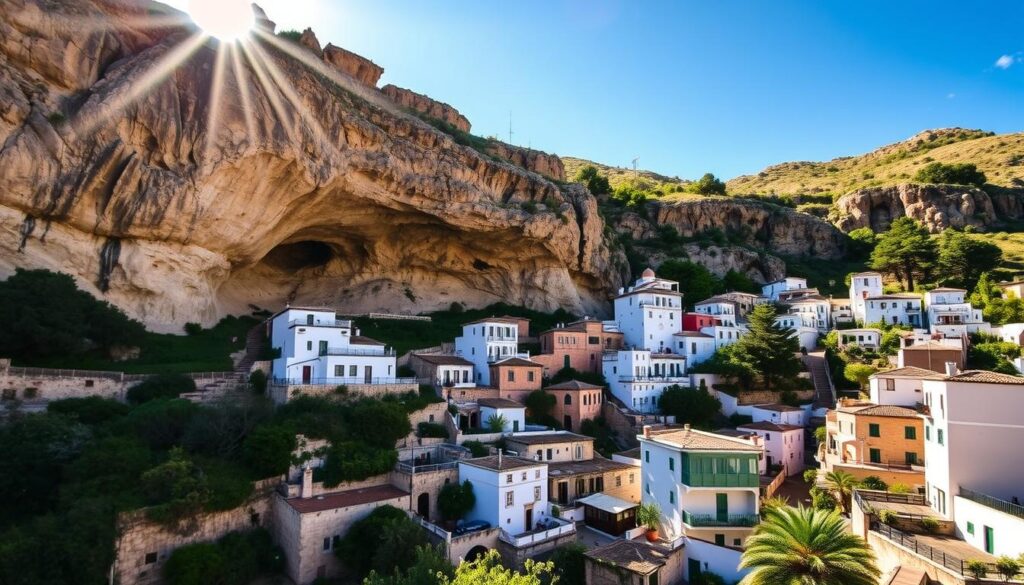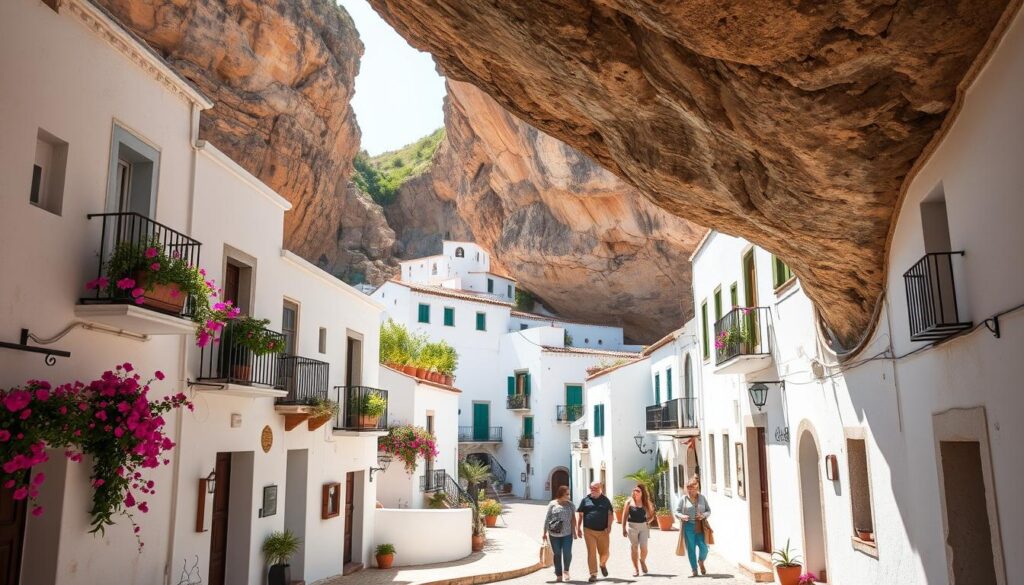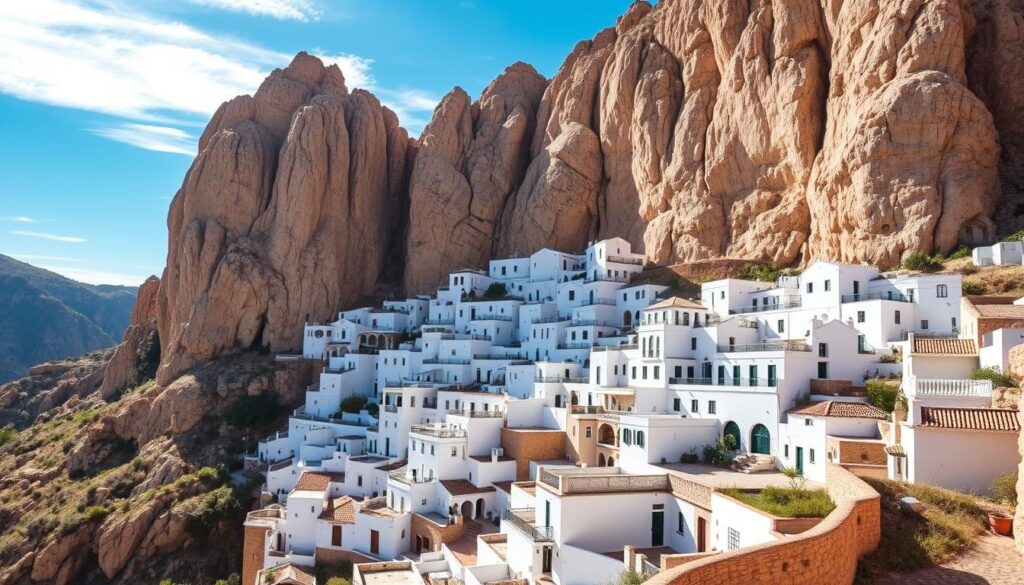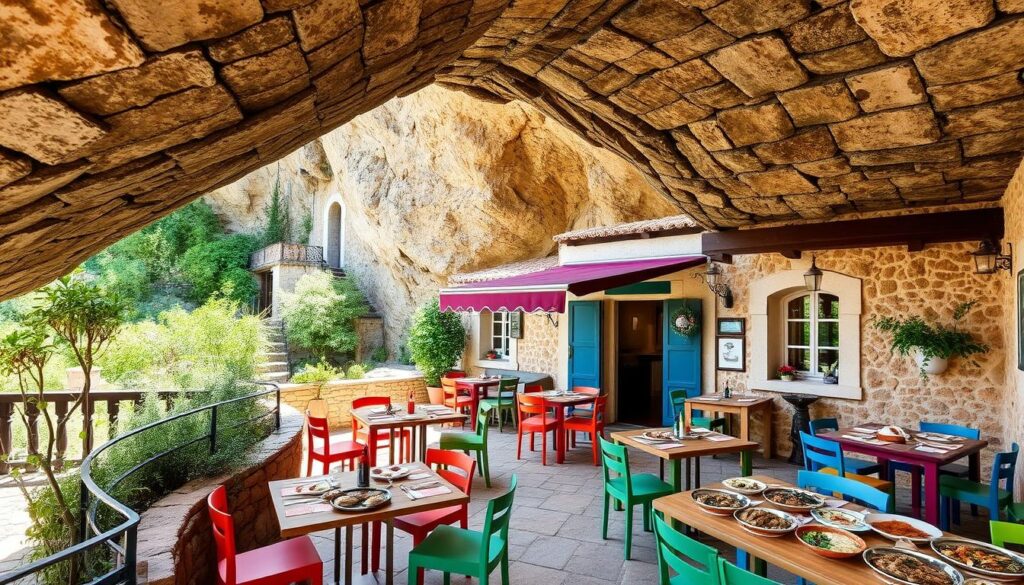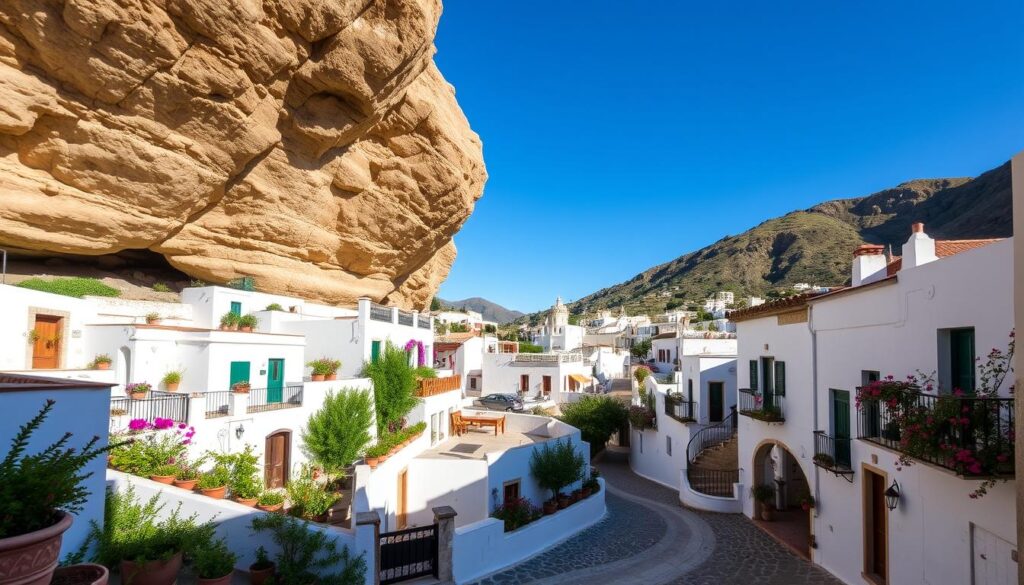Setenil de las Bodegas amazed me with its gravity-defying homes. Houses nestled snugly beneath massive rock overhangs. As I explored, I felt wonder and connection to the past.
This unique Andalusian town sits in a river gorge. Its buildings blend seamlessly with the rocky landscape. The sight of houses built into cliffs showcases human ingenuity.
Setenil’s charm extends beyond its architecture. With only 3,000 residents, it boasts five churches and a 12th-century castle. The town’s rich history is evident everywhere.
Setenil’s culinary offerings are equally impressive. Local restaurants serve dishes made with famous pork products. The aroma of sopa cortijera, a hearty soup, filled the air.
This hidden gem offers more than views and food. It’s where history comes alive. Setenil blends Moorish influences with Christian heritage.
Key Takeaways
- Setenil de las Bodegas is home to about 3,000 residents
- The town features unique cave dwellings and houses built into rock overhangs
- It’s part of Andalusia’s White Villages route but stands out due to its location in a river gorge
- Setenil boasts five churches and a 12th-century castle
- Local cuisine includes famous pork products and the hearty sopa cortijera soup
- The town is just a 30-minute drive from the popular tourist destination of Ronda
Discovering the Hidden Gem of Andalusia
Setenil de las Bodegas Cádiz Spain is a captivating town in Andalusia’s heart. It’s listed as one of Spain’s Most Beautiful Towns. This remarkable place blends history, architecture, and natural beauty seamlessly.
Location and Geography
Setenil de las Bodegas sits in a canyon carved by two rivers. It’s located in Cádiz province, southwestern Andalusia. The town’s unique geography shapes its distinctive appearance and rich culture.
Historical Significance
Setenil’s history spans centuries, with nearby caves showing prehistoric habitation. In medieval times, it became a wine storage and trading hub. This is reflected in its rock-carved underground cellars.
Unique Architecture
Setenil’s most striking feature is its cave dwellings. White-washed buildings seem to grow from the mountain. Many homes have just one external wall, with living quarters under rock overhangs.
The 15th-century Church of Our Lady of the Incarnation blends Gothic and Renaissance styles. The 12th-century Castle of Setenil offers stunning views of the town and countryside.
These architectural wonders, along with the unique cave houses, create an unforgettable sight. Visitors to Setenil de las Bodegas are treated to one of Europe’s most original villages.
The Origin and Meaning Behind the Name
The setenil etymology is intriguing. Setenil de las Bodegas has a name steeped in history. It likely comes from “septem nihil,” meaning “seven times no” in Latin.
This name reflects the town’s strong resistance during the Reconquista. It shows the determination of its people throughout history.
“De las Bodegas” was added in the 15th century. It refers to the wineries that flourished after the Christian conquest. Sadly, these wineries suffered in the 1860s.
A phylloxera insect infestation destroyed most European vine stocks. This event greatly impacted the local wine industry.
Setenil’s name still echoes its rich past. The town’s population has remained steady over time. In 2005, it had 3,016 people living across 82 km².
This stability shows Setenil’s enduring spirit. It mirrors the town’s ability to overcome challenges, just like during the Reconquista.
“Setenil de las Bodegas: Where history and resilience blend like fine wine.”
A Journey Through Time: Setenil’s Rich History
Setenil de las Bodegas boasts a captivating history spanning centuries. This unique town’s story predates its 1484 founding. People have lived here since prehistoric times, shaping the landscape and culture.
Roman and Moorish Influences
Romans settled here in the 1st century AD, setting the stage for future growth. The Moors later transformed Setenil into a powerful fortress. The Castillo de Setenil de las Bodegas, a 12th-century stronghold, showcases this era.
The Reconquista and Christian Era
Christian reconquest marked a pivotal moment for Setenil. It took seven attempts to capture the castle over 15 days. In 1501, the Catholic Monarchs granted Setenil special trade privileges.
This boost rivaled Sevilla’s status and helped Setenil thrive. By 1564, it featured in Joris Hoefnagel’s atlas of Europe’s most important towns.
Modern-Day Revival
Setenil faced setbacks, including an 1880s insect plague that destroyed its vineyards. Yet, the town has bounced back impressively. Today, Setenil houses 3,000 residents and boasts over 30 rural guesthouses.
Local businesses thrive alongside a growing tourist trade. Unique cave dwellings and rich history continue to charm visitors. In 2018, Setenil joined Spain’s Most Beautiful Villages list.
“Setenil de las Bodegas is a living testament to human resilience and ingenuity, where past and present blend seamlessly in the rock-hewn streets.”
Setenil de las Bodegas: A Troglodyte Wonder
Setenil de las Bodegas is a unique Andalucian gem. Its cave houses blend with massive rock formations. The sight is truly breathtaking.
The town’s architecture shows amazing ingenuity. Rock formations serve as natural roofs and walls. It’s humans adapting to nature, not changing it.
These cave dwellings have a long history. Nearby caves were inhabited over 25,000 years ago. Today, modern amenities mix with ancient stone.
“Living in a cave house is like being wrapped in a cocoon of history,” a local resident told me.
Cave houses offer great natural insulation. They’re cool in summer and warm in winter. Some caves now house modern homes, shops, and even banks.
Others keep their rustic charm. They remind us of times when people and animals shared these spaces.
Setenil de las Bodegas offers more than cave houses. It has a 13th-century castle and old Jewish neighborhoods. Outdoor lovers can enjoy hiking, birdwatching, and kayaking.
Exploring the Cave Streets: A Walking Tour
Setenil de las Bodegas offers a unique walking tour. This small town blends history and architecture beautifully. With less than 3,000 people, it’s a charming place to explore.
Calle Cuevas de la Sombra
My first stop was Calle Cuevas de la Sombra, or Shade Street. This rock-ceilinged street amazes visitors with its natural beauty. Walking under the massive rock overhang felt like entering another world.
La Cueva del Iberico, a local shop, caught my attention. It offers an impressive selection of cheeses and local produce.
Calle Cuevas del Sol
Calle Cuevas del Sol, or Sun Street, is the most photographed area. Whitewashed houses seem to grow from the cliff face. It’s beautiful but can get crowded with tour groups.
Plaza de Andalucía
Plaza de Andalucía is the heart of Setenil. Here, tapas bars nestle into cave-like structures. Even a bank is built into the rock.
For a panoramic view, climb the steps to Mirador del Carmen. The Torre del Homenaje offers breathtaking vistas for a small fee.
This two-hour walking tour shows Setenil’s best features. It’s perfect for a day trip from nearby cities like Ronda or Malaga.
Architectural Marvels: Houses Built into the Rocks
Setenil de las Bodegas boasts unique architecture that blends human skill with nature’s beauty. Houses appear to grow from the rocky landscape. This creates a sight that’s both stunning and surreal.
The cave houses in Spain blend perfectly with their surroundings. Many homes have one external wall, while the rest extend into natural caves. Massive sandstone overhangs act as natural roofs for these dwellings.
These cave houses are incredibly practical. Thick rock walls keep interiors cool in summer and warm in winter. Small windows help regulate temperature naturally, showing the wisdom of this ancient technique.
“Living in Setenil is like being cradled by the earth itself,” a local resident told me, capturing the essence of this unique architectural style.
About 3,000 people call these rock-carved homes their own. Setenil de las Bodegas shows how architecture can work with nature. It’s a living example of sustainable building practices that have lasted for centuries.
Local Cuisine and Gastronomy
Setenil de las Bodegas is a food lover’s paradise. The town’s cuisine reflects its rich history and agricultural roots. You’ll find a variety of traditional dishes and local specialties here.
Traditional Dishes
Meat lovers will adore Setenil’s food scene. The town is famous for its chorizo and pork dishes. Try the sopa cortijera, a hearty soup with wild asparagus, eggs, and sausage.
Sweet potato with honey offers a perfect blend of savory and sweet. These dishes showcase Setenil’s expertise in creating delicious meals.
Wine and Olive Production
Setenil’s name hints at its winemaking history. Local vineyards offer tours and wine tastings. Olive groves produce high-quality oil that enhances every dish.
These local products are key to Setenil’s unique food identity. They add depth and flavor to the town’s culinary offerings.
Best Restaurants and Tapas Bars
Bar la Escueva is a top choice, ranked 2nd out of 19 local restaurants. For a special meal, visit El Patio de Maria Teresa. They serve delicious ham croquettes and grilled Iberian pork.
Tapas fans should check out Bar Frasquito. It’s known for fried eggplant with melted goat cheese. These spots offer a taste of Setenil’s best flavors.
Prices in Setenil vary, with some places costing more than in nearby Ronda. However, the unique cave-dining experience makes it worthwhile. Spanish lunch is typically from 2-4 PM, with restaurants reopening around 8 PM.
Cultural Attractions and Points of Interest
Setenil de las Bodegas offers a unique blend of history and architecture. The town’s layout is captivating, with winding cobbled streets nestled between rocks. Its center is embedded in the Trejo river gorge.
The Nuestra Señora de la Encarnación Church is a striking feature. Built between the 15th and 17th centuries, it stands on an old mosque site. The Torre del Homenaje, a formidable defense tower, now hosts temporary exhibitions.
El Lizón Viewpoint offers breathtaking views of the village’s unique architecture. The Arab Castle, dating to the 12th century, provides insight into Setenil’s medieval past. Only one tower remains, but it’s worth visiting.
The town’s cave houses are a marvel. Many are now tourist attractions, including rural accommodations and hotels. Calle Cuevas del Sol features amazing cave restaurants tucked under massive overhanging rocks.
“Setenil de las Bodegas is a living museum where every street tells a story,” remarked a local guide during my visit.
Religious architecture enthusiasts should explore the Hermitage of the Virgin of Carmen. This 18th-century gem offers a glimpse into Setenil’s spiritual heritage. The Hermitage of San Benito in the historic quarter is also worth visiting.
Spring or autumn are ideal times to experience Setenil de las Bodegas. The weather is pleasant then, and you’ll avoid summer crowds. These seasons are perfect for exploring the town’s unique cultural landscape.
Practical Information for Visitors
Setenil de las Bodegas offers a unique blend of history, architecture, and natural beauty. This guide provides essential details for a smooth and memorable visit. The town is part of the Route of the White Villages in Cadiz Province.
How to Get There
Setenil de las Bodegas is easily accessible by car from major cities. It’s a 30-minute drive from Ronda and about 1 hour and 45 minutes from Seville or Cadiz. From Malaga, the journey takes around 1 hour and 20 minutes.
The town’s entrance offers convenient parking. This makes it easy to start your exploration right away.
Best Time to Visit
Weather plays a key role in planning your trip to Setenil de las Bodegas. Spring and fall offer mild temperatures, ideal for exploring the cave streets. Summer can be hot, but the rock formations provide natural cooling.
Winter visits offer a less crowded experience. You’ll also get to see the town in a different light.
Accommodation Options
Setenil de las Bodegas offers a range of charming accommodation options. Over 30 casas rurales (rural houses) cater to tourists. Some are even converted from cave houses for a truly unique stay.
Spring House and Rural House Los Tajos offer comfortable lodging with free WiFi and continental breakfast. For an immersive experience, consider staying in one of the cave houses.
FAQ
Where is Setenil de las Bodegas located?
Setenil de las Bodegas is in Cádiz, Andalusia, Spain. It’s nestled in a canyon carved by the Río Trejo and Río Guadalporcún.
What makes Setenil de las Bodegas unique?
Setenil de las Bodegas is famous for its cave dwellings and rock-embedded houses. It’s one of Europe’s most distinctive villages. White-washed buildings seem to grow out of the mountain.
What is the origin of the name “Setenil de las Bodegas”?
“Setenil” likely comes from Latin “septem nihil” (seven times nothing). It refers to the town’s resistance to seven sieges. “De las Bodegas” was added later, referring to local wineries.
What is the history of Setenil de las Bodegas?
Setenil de las Bodegas has roots in Roman times, possibly earlier. It was a key Moorish stronghold until 1484. In the 16th century, it appeared in an atlas of important European towns.
How long have people lived in the cave dwellings of Setenil de las Bodegas?
Cave living in Setenil de las Bodegas dates back to prehistoric times. People occupied natural caves during Paleolithic and Neolithic eras. Today, some caves are modern homes, shops, and even a bank.
What are some popular attractions in Setenil de las Bodegas?
Popular spots include Calle Cuevas de la Sombra and Calle Cuevas del Sol. Plaza de Andalucía offers tapas bars and a unique cave bank. The Torreón del Homenaje tower provides panoramic views.
What is the local cuisine like in Setenil de las Bodegas?
Setenil de las Bodegas is known for excellent meat products like chorizo and pork. Local dishes include sopa cortijera and asparagus revueltos. The town is famous for its wines and olive production.
How do I get to Setenil de las Bodegas?
Setenil de las Bodegas is 18 km from Ronda and 95 km from Málaga. You can reach it by car, with parking available at the town’s entrance.
When is the best time to visit Setenil de las Bodegas?
Spring and fall offer mild weather, ideal for visiting. Summer can be hot. Winter provides a unique, less crowded experience.
Where can I stay in Setenil de las Bodegas?
Over 30 casas rurales (rural houses) are available for tourists. Some cave houses offer unique lodging experiences.


